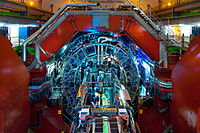
Photo from wikipedia
We consider unfavoured light quark/antiquark to $D$ meson fragmentation. We discuss nonperturbative effects for small transverse momenta. The asymmetry for $D^+$ and $D^-$ production measured by the LHCb collaboration provides… Click to show full abstract
We consider unfavoured light quark/antiquark to $D$ meson fragmentation. We discuss nonperturbative effects for small transverse momenta. The asymmetry for $D^+$ and $D^-$ production measured by the LHCb collaboration provides natural constraints on the parton (quark/antiquark) fragmentation functions. We find that already a fraction of $q/{\bar q} \to D$ fragmentation probability is sufficient to account for the measured asymmetry. We make predictions for similar asymmetry for neutral $D$ mesons. Large $D$-meson production asymmetries are found for large $x_F$ which is related to dominance of light quark/antiquark $q/\bar q \to D$ fragmentation over the standard $c \to D$ fragmentation. As a consequence, prompt atmospheric neutrino flux at high neutrino energies can be much larger than for the conventional $c \to D$ fragmentation. The latter can constitute a sizeable background for the cosmic neutrinos claimed to be observed recently by the IceCube Observatory. Large rapidity-dependent $D^+/D^-$ and $D^0/{\bar D}^0$ asymmetries are predicted for low ($\sqrt{s} =$ 20 - 100 GeV) energies. The $q/\bar q \to D$ fragmentation leads to enhanced production of $D$ mesons at low energies. At $\sqrt{s}$ = 20 GeV the enhancement factor with respect to the conventional contribution is larger than a factor of five. In the considered picture the large-$x_F$ $D$ mesons are produced dominantly via fragmentation of light quarks/antiquarks. Predictions for fixed target $p+^{4}\!\textrm{He}$ collisions relevant for a fixed target LHCb experiment are presented.
Journal Title: Physical Review D
Year Published: 2018
Link to full text (if available)
Share on Social Media: Sign Up to like & get
recommendations!